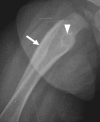Osteoid osteoma of the femur in a 7-month-old infant treated with radiofrequency ablation
- PMID: 20694724
- PMCID: PMC2939336
- DOI: 10.1007/s00256-010-1014-1
Osteoid osteoma of the femur in a 7-month-old infant treated with radiofrequency ablation
Abstract
Osteoid osteoma occurs most commonly in children, adolescents, and young adults between the ages of 5 and 30 years. In the preschool age group, it is quite uncommon, accounting for only 3-8% of all osteoid osteoma cases. We report a case of osteoid osteoma in a 7-month-old infant, who presented with decreased use of the right lower extremity due to pain. Magnetic resonance imaging (MRI) showed an atypical appearance. A biopsy of the lesion, with histopathological examination, confirmed the diagnosis of osteoid osteoma. Radiofrequency ablation (RFA) of the nidus under computed tomography (CT) guidance was performed. The patient developed a recurrence after 3 months, which was treated with a second RFA. On subsequent follow-up, the infant did not show signs of pain after 1 month. In summary, this case report shows that osteoid osteoma can present in early infancy and can be successfully treated with RFA at this age, however, recurrence after the procedure can occur and close follow-up is recommended.
Figures





Similar articles
-
Contrast-enhanced MRI predicts local recurrence of osteoid osteoma after radiofrequency ablation.J Med Imaging Radiat Oncol. 2012 Dec;56(6):617-21. doi: 10.1111/j.1754-9485.2012.02443.x. Epub 2012 Sep 5. J Med Imaging Radiat Oncol. 2012. PMID: 23210580
-
Multicentric, multifocal, and recurrent osteoid osteoma of the hip: first case report.BMC Musculoskelet Disord. 2019 Apr 16;20(1):171. doi: 10.1186/s12891-019-2552-x. BMC Musculoskelet Disord. 2019. PMID: 30991974 Free PMC article.
-
Intraarticular Osteoid Osteoma: MRI Characteristics and Clinical Presentation Before and After Radiofrequency Ablation Compared to Extraarticular Osteoid Osteoma.Rofo. 2020 Dec;192(12):1190-1199. doi: 10.1055/a-1181-9041. Epub 2020 Jul 8. Rofo. 2020. PMID: 32643768 English, German.
-
Osteoid osteoma with a multicentric nidus: a case report and review of the literature.Arch Orthop Trauma Surg. 2007 Dec;127(10):863-6. doi: 10.1007/s00402-007-0421-9. Epub 2007 Sep 8. Arch Orthop Trauma Surg. 2007. PMID: 17828412 Review.
-
CT-guided radiofrequency ablation of osteoid osteoma: established concepts and new ideas.Br J Radiol. 2020 Oct 1;93(1114):20200266. doi: 10.1259/bjr.20200266. Epub 2020 Jun 24. Br J Radiol. 2020. PMID: 32520586 Free PMC article. Review.
Cited by
-
Osteoid osteoma: the great mimicker.Insights Imaging. 2021 Mar 8;12(1):32. doi: 10.1186/s13244-021-00978-8. Insights Imaging. 2021. PMID: 33683492 Free PMC article. Review.
-
Atypical osteoid osteomas.Eur J Orthop Surg Traumatol. 2015 Jan;25(1):17-27. doi: 10.1007/s00590-013-1291-1. Epub 2013 Aug 23. Eur J Orthop Surg Traumatol. 2015. PMID: 23975583 Review.
-
Successful percutaneous treatment of osteoid osteoma in a 13 month-old boy with radiofrequency ablation under CT guidance.Acta Orthop Traumatol Turc. 2019 May;53(3):233-237. doi: 10.1016/j.aott.2018.10.002. Epub 2018 Nov 13. Acta Orthop Traumatol Turc. 2019. PMID: 30446252 Free PMC article.
-
The usefulness of chemical-shift magnetic resonance imaging for the evaluation of osteoid osteoma.Radiol Bras. 2018 May-Jun;51(3):156-161. doi: 10.1590/0100-3984.2017.0037. Radiol Bras. 2018. PMID: 29991836 Free PMC article.
-
Intramedullary osteoid osteoma in the humerus of a toddler-A case report and review of the literature.Radiol Case Rep. 2022 Aug 5;17(10):3748-3753. doi: 10.1016/j.radcr.2022.07.073. eCollection 2022 Oct. Radiol Case Rep. 2022. PMID: 35965924 Free PMC article.
References
-
- Dorfman HD, Czerniak B. Benign osteoblastic tumors. In: Dorfman HD, Czerniak B, editors. Bone tumors. St. Louis: Mosby; 1998. pp. 85–127.
-
- Jackson RP, Reckling FW, Mants FA. Osteoid osteoma and osteoblastoma. Similar histologic lesions with different natural histories. Clin Orthop Relat Res. 1977;128:303–313. - PubMed
-
- Habermann ET, Stern RE. Osteoid-osteoma of the tibia in an eight-month-old boy. A case report. J Bone Joint Surg Am. 1974;56:633–636. - PubMed

